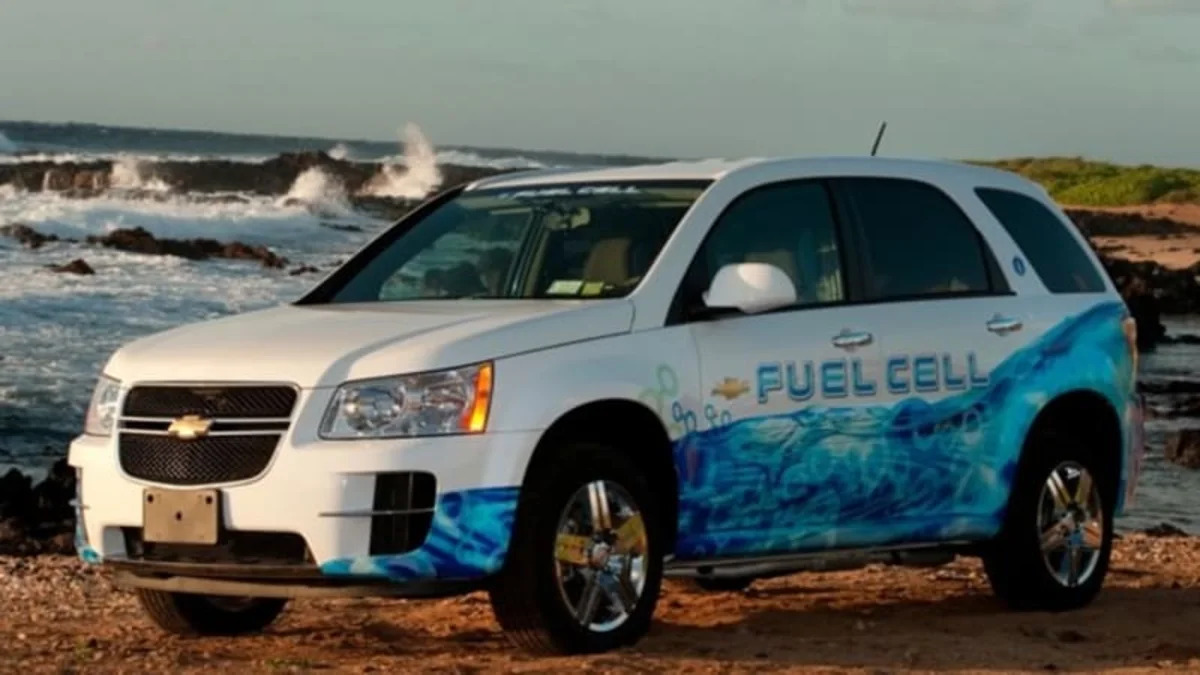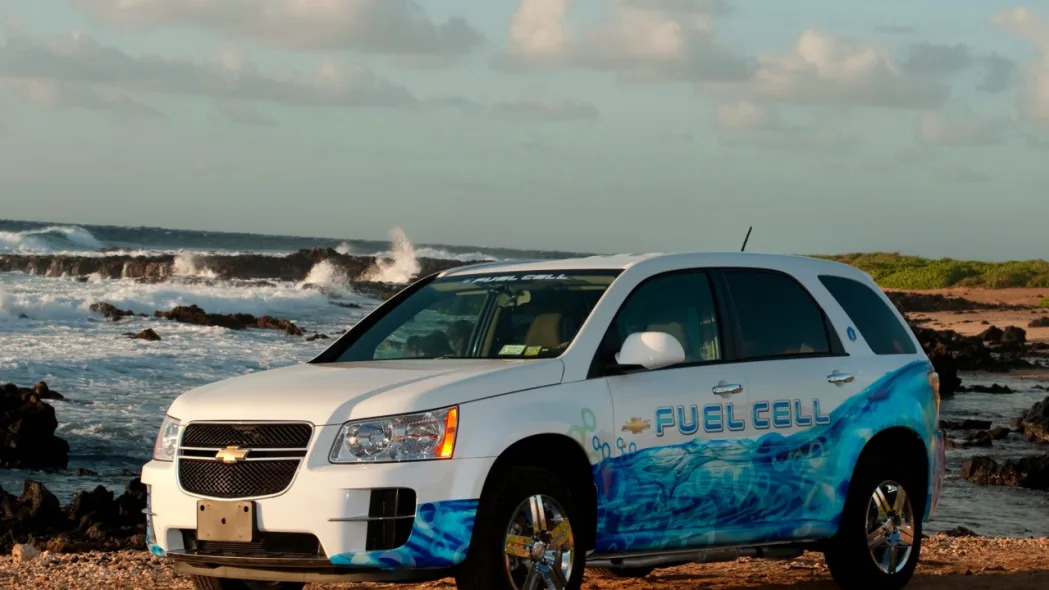Just because the overall mood in the advanced automotive technology field has shifted pretty much into a plug-in vehicle direction doesn't mean that hydrogen fuel cells are dead and buried. Even in a place as tailor-made for electric vehicles as Hawai'i, the fight for H2 continues.
Today, GM and The Gas Company announced that ten organizations have joined the Hawaii Hydrogen Initiative (H2I), a plan to get around two dozen H2 stations installed on O'ahu by 2015. The deal was first announced in May. The ten new partners are: the state Department of Business, Economic Development and Tourism (DBEDT); U.S. Department of Energy; FuelCell Energy; Aloha Petroleum Ltd; Louis Berger Group; U.S. Pacific Command, supported by the U.S. Pacific Fleet, U.S. Pacific Air Forces, U.S. Army Pacific, and U.S. Marine Forces, Pacific; National Renewable Energy Laboratory; the County of Hawaii; University of California – Irvine, and the University of Hawaii. So, government, education, military and a petroleum company.
On the one hand, since the state imports every drop of oil it uses, anything that helps reduce the load is a good thing. Also, given O'ahu's small size, a small number of stations could easily support the 10,000 fuel cell vehicles that The Gas Company says it could easily supply with H2 today. Of course, Oahu's small size also means it's perfect for electric vehicles.
This announcement doesn't mean that EV advocates are quietly exiting the state. Nope. Coda Automotive is supposedly going to try to sell vehicles there, as is Better Place. (In 2008, Phoenix declared it would sell cars there in 2009, but that never happened.) On December 30th, local plug-in fans will be hosting an electric car rally – and they hope President Obama and his family will come by during their winter vacation in the islands. For a look at the history of electric vehicles in Hawai'i, read this and this. And, to get one anti-hydrogen perspective from someone in the islands, read this column from the Maui News. He's mad at outgoing governor Linda Lingle and the $10 million she "wasted on the hydrogen economy."
Today, GM and The Gas Company announced that ten organizations have joined the Hawaii Hydrogen Initiative (H2I), a plan to get around two dozen H2 stations installed on O'ahu by 2015. The deal was first announced in May. The ten new partners are: the state Department of Business, Economic Development and Tourism (DBEDT); U.S. Department of Energy; FuelCell Energy; Aloha Petroleum Ltd; Louis Berger Group; U.S. Pacific Command, supported by the U.S. Pacific Fleet, U.S. Pacific Air Forces, U.S. Army Pacific, and U.S. Marine Forces, Pacific; National Renewable Energy Laboratory; the County of Hawaii; University of California – Irvine, and the University of Hawaii. So, government, education, military and a petroleum company.
On the one hand, since the state imports every drop of oil it uses, anything that helps reduce the load is a good thing. Also, given O'ahu's small size, a small number of stations could easily support the 10,000 fuel cell vehicles that The Gas Company says it could easily supply with H2 today. Of course, Oahu's small size also means it's perfect for electric vehicles.
This announcement doesn't mean that EV advocates are quietly exiting the state. Nope. Coda Automotive is supposedly going to try to sell vehicles there, as is Better Place. (In 2008, Phoenix declared it would sell cars there in 2009, but that never happened.) On December 30th, local plug-in fans will be hosting an electric car rally – and they hope President Obama and his family will come by during their winter vacation in the islands. For a look at the history of electric vehicles in Hawai'i, read this and this. And, to get one anti-hydrogen perspective from someone in the islands, read this column from the Maui News. He's mad at outgoing governor Linda Lingle and the $10 million she "wasted on the hydrogen economy."
[Source: GM]
PRESS RELEASE
Hawaii Hydrogen Infrastructure Gets Boost
Collaboration of Industry, Academia and Government Commits to 2015
2010-12-08
HONOLULU – Ten companies, agencies and universities have joined an initiative between The Gas Company (TGC), and General Motors to make hydrogen-powered vehicles and a fueling infrastructure a reality in Hawaii by 2015.
The plan, called the Hawaii Hydrogen Initiative (H2I), aims to integrate hydrogen as an essential building block for Hawaii's sustainable energy ecosystem. The effort to reduce the state's 90 percent dependence on imported oil is expected to make hydrogen available to all of Oahu's 1 million residents by 2015. The goal is for 20 to 25 hydrogen stations to be installed in strategic locations around the island.
"Hydrogen, used as a fuel, will reduce our dependence on petroleum starting today," said Jeff Kissel, TGC president and CEO.
The plan builds on a May 2010 memorandum of understanding between TGC, one of Hawaii's major utilities, and GM. TGC today produces enough hydrogen to power up to 10,000 fuel cell vehicles and has the capacity to produce much more hydrogen. GM is a leader in hydrogen fuel cell vehicles and fielded the world's largest fuel cell demonstration fleet – more than 100 vehicles – beginning in 2007.
The hydrogen initiative partners are evaluating methods to distribute hydrogen through existing natural gas pipelines, addressing the long-standing problem of how to cost effectively produce and distribute hydrogen.
"In Hawaii, we want to address the proverbial chicken or egg dilemma," said Charles Freese, executive director of GM Fuel Cell Activities. "There has always been a looming issue over how to ensure that the vehicles and the necessary hydrogen refueling infrastructure are delivered to market at the same time. Our efforts in Hawaii will help us meet that challenge.
"Once the key hydrogen infrastructure elements are proven in Hawaii, other states can adopt similar approaches," Freese said. "Germany, Japan and Korea are all building hydrogen infrastructures within this same timeframe. The work in Hawaii can provide a template for other regions."
In addition to GM and TGC, the hydrogen initiative partners include the state Department of Business, Economic Development and Tourism (DBEDT); U.S. Department of Energy; FuelCell Energy; Aloha Petroleum Ltd; Louis Berger Group; U.S. Pacific Command, supported by the U.S. Pacific Fleet, U.S. Pacific Air Forces, U.S. Army Pacific, and U.S. Marine Forces, Pacific; National Renewable Energy Laboratory; the County of Hawaii; University of California – Irvine, and the University of Hawaii.
"Hawaii is on the cutting edge of developing the infrastructure for hydrogen-powered vehicles and adopting the latest clean energy technologies to move our islands toward energy independence and sustainability," said Richard Lim, acting director, state Department of Business, Economic Development and Tourism. "H2I is a unique, innovative partnership that has brought together public, private and community partners to improve the quality of life for our citizens and become a worldwide model."
In 2008, the state launched the Hawaii Clean Energy Initiative (HCEI), a partnership with the U.S. DOE with a goal of generating 70 percent or more of Hawaii's energy through energy efficiency and clean, renewable resources such as solar, wind, wave, biofuels, and geothermal.
About General Motors – General Motors Company (NYSE:GM, TSX: GMM), one of the world's largest automakers, traces its roots back to 1908. With its global headquarters in Detroit, GM employs 209,000 people in every major region of the world and does business in more than 120 countries. GM and its strategic partners produce cars and trucks in 31 countries, and sell and service these vehicles through the following brands: Buick, Cadillac, Chevrolet, GMC, Daewoo, Holden, Isuzu, Jiefang, Opel, Vauxhall, and Wuling. GM's largest national market is China, followed by the United States, Brazil, the United Kingdom, Germany, Canada, and Russia. GM's OnStar subsidiary is the industry leader in vehicle safety, security and information services. General Motors acquired operations from General Motors Corporation on July 10, 2009, and references to prior periods in this and other press materials refer to operations of the old General Motors Corporation. More information on the new General Motors can be found at www.gm.com.
About The Gas Company LLC – The Gas Company is a Hawaii-based, wholly owned subsidiary of Macquarie Infrastructure Company (NYSE: MIC – www.macquarie.com/mic). MIC owns, operates, and invests in a diversified group of infrastructure businesses that provide basic services to customers across the United States. www.hawaiigas.com.



Sign in to post
Please sign in to leave a comment.
Continue